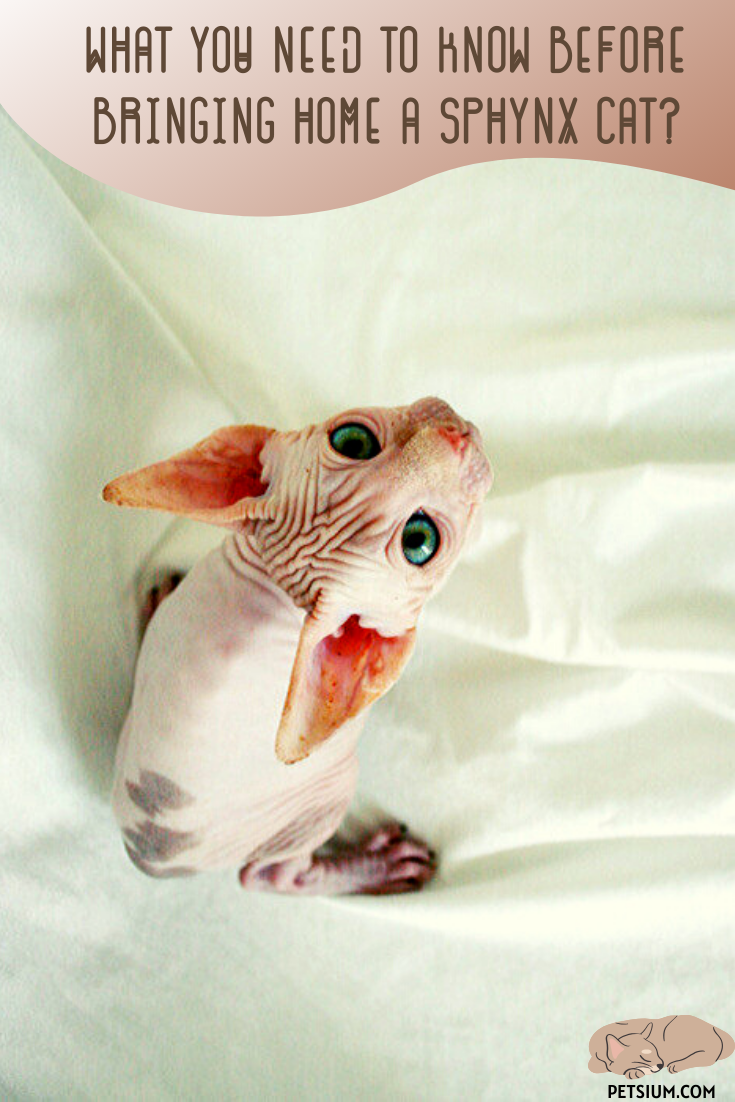The Sphynx Cat is a very inquisitive, intelligent and playful cat. Sphynx also have a very unique appearance in that they appear hairless–but in reality, the Sphynx actually has different degrees of hairlessness.
Some are completely bald while others have various levels of fuzz or peachy down. Some Sphynx, as they get older, may get a little fuzzy as well. Sphynx also come in a variety of colors such as red (orange), black, blue (gray), tortie, and bi-color.
Sphynx Cats are often referred to as part monkey, part child, and part dog, and many will come when called and also meet you at the door, ready to play! Sphynx love to sleep with you at night, and will snuggle right up against you for warmth.

Post Navigation
Sphynx Cat Origin
The Sphynx Cat does not come from Egypt as many think but originated in Toronto Ontario, Canada, where in 1966 a naked baby was born into a litter of hairy cats. This was the beginning of the Sphynx breed that we know today. The Sphynx name was given at a later date because of the similarity they bore to the Sphinx statues.
Sphynx Cats (also called Canadian Sphynx, Canadian Hairless, Moonstone Cat, Moon Cat, Wrinkled Cat) first showed up in Canada during the 1960’s but the original breed is thought to have passed on. However, breeders from Canada, Europe, and Minnesota recreated the breed in the 1970’s.
History of the Sphynx
The Sphynx is a rare cat that is known to lack a coat. Evidence shows that hairless cats come mutations in the cat population. These mutations can occure in the population up to every 15 to 20 years.
The modern version of the Sphynx came about in the late 60’s in Toronto Canada, when there was the birth of a hairless kitten who was dubbed Prune. The cat was then crossed with its mother, which led to another hairless cat. Prune with a few other naked cats became the founders of the Sphynx breed.
As with most mutated species the first Sphynx faced several problems such as a very limited genetic pool, and breeders did not have much information on the cats so many died. Later a male Epidermis was born in the year 1975. His mother was short-haired, this breed provided new genes for the Sphynx lovers to mix their cats with.
Early on crosses with the Devon-rex were used most of the time but as time went on this became a taboo because it caused health and devolution problems. The Sphynx is now a breed with a sturdy gene pool.
Sphynx Cat Care
Your Sphynx kitten does require a bit of maintenance that a cat with hair does not require. Regular bathing, nail cleaning and ear cleaning are necessary, but usually not a problem, as Sphynx kittens start this at an early age and most are used to it by the time they go to their new homes.
Sphynx Cat Fur
Although the Sphynx looks like a bald cat this is not the case. They have a higher core temperature than other cats and their skin texture resembles Chamois leather. Sometimes the coat is covered with a fine peach like coat of hair.
Because of the lack of much hair Sphynx Cats should not be kept in the sun for too long or they will burn, they should also reside in a warmer climate because they are sensitive to temperature changes. These cats can often be seen cuddled up to other people or animals trying to stay warm, this is to make up for the lack of fur on their coats.
Most of them even sleep under the covers at night with their owners. In the colder winter months they often spend their time under blankets or cuddled up to a warm person. The lack of fur makes these cats feel very warm when touched. Sometimes they have whiskers and eyebrows and sometimes they do not.
Although they do not have fur their skin is the color their fur would be and they have all the normal marking of other cats, such as solid, van, or tabby. Because of the lack of fur these cats need to be washed more often, the fur normally soaks up the oils of the skin but without fur these need to be washed off more regularly.
Sphynx Cat Appearance
The Sphynx has an adorable, wedge-shaped head with extra large ears, which are 3 inches or higher in adults and lemon-shaped eyes. They have a thin whippy tail and soft, wrinkly skin. With a medium, muscular build and a cute little pot belly, these guys and gals are hard to resist.
They have long, slender legs with well-muscled thighs. Their precious toes look like tiny baby fingers and they use them to pick things up and hold them.
Like a sociable dog, the Sphynx can be taught to walk on a leash and cherishes a good game of fetch. They’re good with children, other cats, and with dogs.

Sphynx Cat Personality
This cat is a friendly. Like a good buddy, he enjoys nothing better than the attention of his human parent and he loves to play games.
They are intelligent and inquisitive. They are very creative when it comes to inventing games and will investigate just about everything in the house including countertops and cupboards.
Don’t be surprised if your Sphynx figures out how to open cupboards with their finger-like toes. It won’t be long before you discover kitty up on the fridge or in other high places.
Sphynx Cat Issues
- They get cold easily.
- Sphynx Cats are vulnerable to sunburn and skin cancer.
- They have a higher chance of developing heart disease (hypertrophic cardiomyopathy).
- Kittens susceptible to respiratory infections.
- They require ear cleanings, nail cleanings, and weekly baths.
- They have a high metabolism and need to eat frequently.
Tips and Solutions
- Keep the house above 70 degrees F.
- Have several warm cat beds around the house.
- Keep them indoors or at least out of the sun.
- Buy or make them a sweater.
- Have them screened for hypertrophic cardiomyopathy (HCM).
- Make sure they always have food available.
Sphynxes are not shy cats, they are very energetic, smart, and like most cats very curious.
A Sphynx Cat/Kitten will give you years of love, friendship and laughter, and once you bring your Sphynx Kitten home, you will wonder how you ever lived without one!




